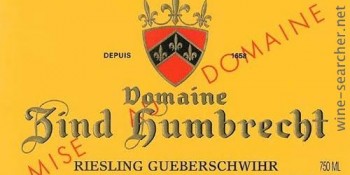If you’re not much of a wine drinker (yet), you might not know that Alsace — that famed region that has sometimes been called Alsace-Lorraine and has flipped back and forth as part of Germany or France since the time of Charlemagne — is actually a vibrant winemaking region. The focus is primarily on white wine, although some light-bodied Pinot Noir is produced as well.
What makes Alsace different from other areas in France? For one, Alsace is one of the few French regions that produces varietal wines rather than blends, possibly due to the influence of winemaking in Germany, where wines are also usually single varietals: wines are named after the grape, rather than the region — virtually unheard of in the rest of France. Similarly, the grapes planted are much more German than they are French: Riesling and Gewürztraminer, for example, along with Pinot Gris, are the three most popular wines of Alsace.
Additionally, the Vosges Mountains cut Alsace off from the Atlantic climate that prevails in most of France. As rain moves from west to east toward Alsace, the mountains block it, leaving Alsace with the driest region in France (particularly in September and October, making for perfect harvest conditions). The sloping, stony foothills of the east side of the mountains provide ideal vineyard locations.
Rieslings from Alsace will probably be the easiest to find, are considered the best in the region, and are usually clean, stony wines with citrus fruit flavors. Alsatian wines are typically void of oak flavors, relying on the pure flavors of the grape and the soil. The Rieslings show that sense of place (or “terroir”) more than just about any other white wine, and as a result of the varied terrain of Alsace, they display a tremendous variety. Wines produced from vines growing at higher altitudes or on rocky soil will show different flavors than those grown in valleys or in loamy, clay soil.
Domaine Zind-Humbrecht (not exactly a French name) is a classic Alsace producer that makes outstanding Rieslings. The 2012 ($20, 90 points from Wine Spectator) displays really well-integrated floral notes, petrol (yes, believe it or not, gasoline is a typical Riesling characteristic), and apple aromas, with a palate of honey, orange, lemon, and apricot flavors. The wine is rich and, like most Rieslings, has an acidic backbone that make it very food-friendly.
Gewürztraminer in general is somewhat of an acquired taste, and those from Alsace are no different. The intensely floral, “perfumey” characteristics are somewhat odd to the novice wino. The 2012 Albert Mann Gewürztraminer ($20) is an intense wine with aromas of peach, honey, and perfume, followed by by bursts of spice, apple, lemon, lychee, and mango on the palate.
Pinot Noir is just about the only red you’ll find from Alsace, and these are normally light-bodied wines, again with very little oak. Trimbach, another classic Alsace producer, makes a Pinot Noir Reserve with fantastic earthy aromas of forest, subtle flowers, and spice, with cranberry and dark cherry flavors on the palate, and very soft, earthy tannins on the finish. Don’t stop with the Pinot Noir — try Trimbach’s Rieslings and Gewürztraminers as well.
Finally, Alsace also produces a fair amount of Pinot Gris, which is called Pinot Grigio in Italy and by some U.S. wineries. If you can find a bottle of Pierre Sparr Mambourg Grand Cru Pinot Gris, give it a try. The flavors are concentrated and intense, with a slightly viscous consistency, and flavors of tropical fruit like pineapple and tangerine, plus apricot, pear, and zesty acidity.
Alsace is also known for its sparkling wine, Crémant d’Alsace, which is widely available. The sparkling rosés are particularly worthwhile.
Alsace is definitely unique within France, and its wines make for a great change of pace. The price is usually right, too, with reasonably priced bottles widely available for $15 to $25.
